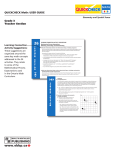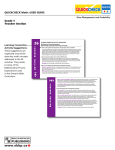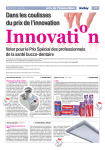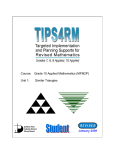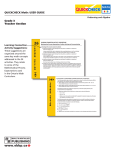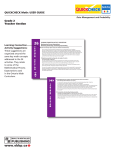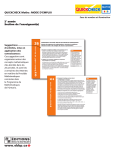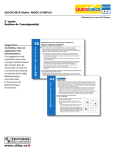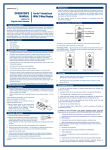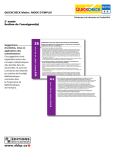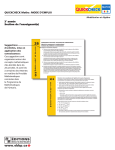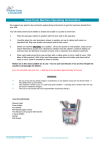Transcript
Quickcheck Math: user guide Measurement Grade 1 Teacher Section Learning Connection Activity Suggestions: These suggestions are organized around the same key math concepts addressed in the 24 activities. They relate to some of the Mathematical Process Expectations used in the Ontario Math Curriculum. 26 T E A C H E R S E C T I O N LEARNING CONNECTION ACTIVITY SUGGESTIONS: Mathematical Process Expectations: Problem Solving, Communicating and Selecting Tools and Computational Strategies Objects can be compared and ordered by the measurable attribute of length or height. Put students in small groups. Challenge each group to order themselves according to height; or length of hair or size of shoes. Give them a time limit to make it fun. Can the rest of the class guess which measurable attribute each group used? Challenge: Have each group prove they ordered themselves correctly. “What unit will you use to measure yourselves: e.g. shoe lengths, connecting cubes, straws?” Remind student of two important things to remember when measuring: 1) The unit you use has to be the same size. E.g. If students use pencils they all have to be the same length. 2) Units have to line up next to eachother with no space in between them. Objects can be compared by the measurable attribute of mass. Using a balance ask partners to determine the relative mass of five objects in the classroom. Ask partners to show their findings graphically from lightest to heaviest. Partners explain how they determined the order shown. Challenge: “Can you make two objects of different masses balance? Show me.” Objects can be compared by the measurable attribute of area. Make a grid for your students on paper using 2 cm squares (or larger on chart paper for small groups). Have students draw a shape with four sides. Ask students to count the number of squares inside the shape and record that number in its centre. Now have them draw a different four-sided shape with the same number of squares inside. Challenge: Have students do the activity above using geoboards. “Which tool, a geoboard or grid paper, is better for measuring area? Tell me / write why.” 1m29.indd int:51 T E A C H E R S E C T I O N 1m29.indd int:52 There is a relationship between the size of a unit and the number of units needed 23/04/09 18:19:54 to measure an object. Measure the length of your classroom three times, using three non-standard units: skipping ropes, straws and connecting cubes. Have someone time each of the three measurements and record the time on a chart. Another student can record the actual measurements. “Which unit’s measurement was the highest? Is there something we can say about the number of units used to measure and their size? Which unit is the best for measuring the length of the classroom? Which unit took the least amount of time? Explain your thinking.” Record the class’s thinking and their conclusions on the board. Challenge: Choose the best unit for measuring the length of a note book. “Tell me why you chose this unit for this job.” A day can be described by the measurable attribute of time to the hour and half hour. Choose a time to the hour or half hour. Show it in two ways. What time will it be in one hour from the time you chose? What time was it an hour before the time you chose? Challenge: Draw a picture of what you do at that time for both AM and PM. 23/04/09 18:19:54

